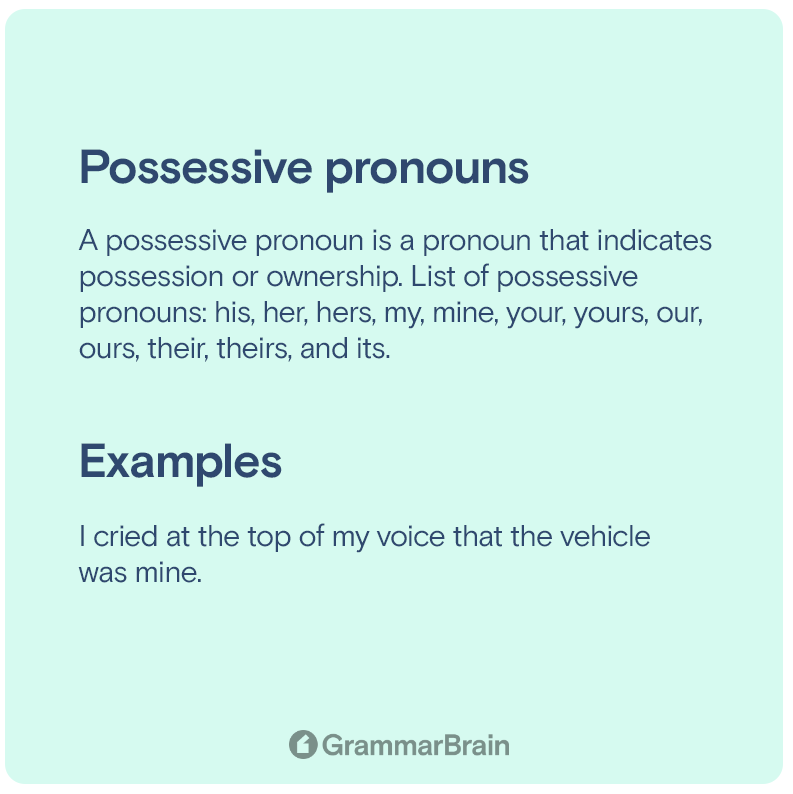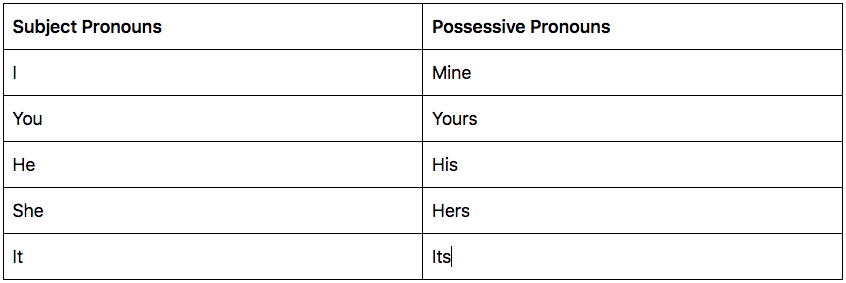What are possessive pronouns? A possessive form is a word construction used to indicate a relationship of possession in a broad sense. This can include ownership, or a number of other types of relation to a greater or lesser degree analogous to that reference.
Learn what possessive pronouns are in this English guide…
What are possessive pronouns?
As we all know, a pronoun is used to define a word that can be used in the place of a noun or noun phrase. Pronouns can be used to denote a noun that has already been referred to before. It can also denote a noun that doesn’t have to be identified specifically.
A possessive pronoun is a pronoun that indicates possession or ownership. List of possessive pronouns: his, her, hers, my, mine, your, yours, our, ours, their, theirs, and its. There are two types of possessive pronouns: strong or absolute possessive pronouns and weak possessive pronouns.
| Subject Pronouns | Possessive Pronouns |
| I | Mine |
| You | Yours |
| He | His |
| She | Hers |
| It | Its |
Example:
“Viola discerned that Nicole’s smartphone was costlier than hers.” In this example, the noun smartphone didn’t have to be repeated twice. It could be replaced by the pronoun “hers” at the end of the sentence. Since this pronoun is used to describe possession of something rather than a noun itself, it is classified as a possessive pronoun.
Strong or absolute possessive pronouns: As mentioned earlier, they are used to substitute a noun that has already been mentioned to avoid repetition. Example: “I cried at the top of my voice that the vehicle was mine.”
The list of absolute possessive pronouns is mine, his, yours, hers, ours, its, theirs, and yours. Out of this list, mine, his, yours, hers, and its are classified as singular possessive pronouns. And ours, theirs, and yours are classified as plural possessive pronouns.
Note that the pronoun “yours” has appeared in both classifications. In the singular type, “yours” denotes a single second person whereas in the second one it denotes multiple second persons.

What are possessive determiners?
In English language grammar, the possessive determiner acts as a function word that appears in front of a noun. And it is used to define ownership or possession of that noun. Example: “My house”, “Her computer”. In the examples mentioned, “my” and “her” are possessive determiners in that they determine who the owner of the following noun is.
Possessive determiners are also known as possessive adjectives or weak possessive pronouns. They are also known by the term genitive pronouns or just as possessives. The list includes my, his, your, her, our, its, their, and your.
What are absolute possessive pronouns?
Absolute possessive pronouns and called absolute because they can be used independently in place of nouns. In other words, they are used to replace nouns.
Example: “Is it Jane’s mobile phone over there? No, it’s not hers.”
In the above example, the underlined word “hers” can be used as a substitute for the original noun “mobile phone” to avoid repetition. Since it can be used in a self-standing manner without dependence on a noun, it is called an absolute possessive pronoun.
Absolute possessive pronouns can also be defined thus. Most of the pronoun types generally require an antecedent which is a noun. But since an absolute possessive pronoun does not require any antecedent, it is rightly called so (absolute).
On the contrary, a weak possessive pronoun, also known as a possessive adjective, cannot be used independently. It has to be used in front of a noun.
Difference between absolute possessive and possessive determiner
As discussed earlier, the main difference between an absolute possessive and a possessive determiner is as follows. The former can be used independently without any antecedent noun while the latter has to be used ahead of a noun.
“Ours is an interesting age of scientific innovation, regularly punctuated by awe-inspiring discoveries and cutting-edge inventions.”
In the previous example, the possessive pronoun “ours” stands independent of any noun. Another necessary condition for the absolute possessive pronoun is that the head noun should be included somewhere in the sentence to provide context. In the example, the head noun is “era”.
Now, consider the following example:
“My phone turned off midway during an important call.”
Here, the pronoun “My” acts as a determiner for the noun “smartphone” and cannot be used without it. Hence the pronoun is called a possessive determiner or weak possessive pronoun.
Now consider the following two variations of a sentence construct:
a) “You know Mel Gibson? A movie of his is being screened in the neighborhood cinema.”
b) “You know Mel Gibson? His movie is being screened in the neighborhood cinema.”
In example a, the pronoun “his” is an absolute possessive and is used in such a way that it is immaterial for us to know which movie of Mel Gibson is being screened. It would suffice to know that one of his movies is being screened. Hence, the use of the absolute possessive pronoun here is more indefinite.
On the other hand, in example b, though not mentioned explicitly, it talks about a specific movie of Mel Gibson that is being screened. So it is less indefinite with the use of a possessive determiner.
| Subject pronouns example | Possessive pronouns example |
| I have a bicycle. | The bicycle is mine. |
| You have a bicycle. | The bicycle is yours. |
| She has a bicycle. | The bicycle is theirs. |
| We have a bicycle. | The bicycle is ours. |
Why are possessive pronouns important?
Possessive pronouns are very important in writing and speech as they aid in making sentences much clearer. They establish the ownership between an object and a subject, and without them, it would be vague with respect to the ownership.
Possessive pronouns also help construct sentences in a much more concise manner as they get rid of the need for any repetition of object names.
Because of these factors, they reduce ambiguity in sentence constructs and aid in enhancing good communication.
Another useful feature of possessive pronouns is that they can represent ownership even without disclosing the specific name of the owner. Thus they can be used in an indefinite manner when it comes to ownership or mentioning the specifics of a person.
Difference between personal pronouns
Personal pronouns are pronouns that are used to substitute the proper name of a person while referring to people or just the name of an animal. They are mainly used to avoid the repetition of proper names which might otherwise make the reading experience much more annoying.
If you had observed closely, in the previous sentence, the pronoun “They” had been used to replace the term “Personal pronouns” from the first sentence. This is done so because repetition of the term “personal pronouns” would have been more cumbersome and even annoying.
Personal pronouns indicate the gender, grammatical person, number, and case of the noun it replaces. Personal pronouns can be subjective or objective. The subjective personal pronouns are I, he, you, she, we, it, and they. The objective ones are me, him, you, her, us, it, and them.
The difference between personal and possessive pronouns is as follows. Personal pronouns only replace and represent the noun either as a subject or an object. Whereas, possessive pronouns replace the noun with an added ownership representation.
Example:
Abraham Lincoln was an outstanding statesman. Abraham Lincoln struggled for abolishing slavery.
When rewritten:
“Abraham Lincoln was an outstanding statesman. He struggled for abolishing slavery.” (Personal Pronoun)
Which car do you think is future-friendly? My car or his car?
When rewritten: “Which car do you think is future-friendly? Mine or his?” (Possessive pronoun)
When to use the apostrophe and comma with possessive pronouns
In the English language, it is common knowledge that we should add an apostrophe to nouns and indefinite pronouns (some, any, all, few, anyone, somebody, etc.) to make them possessive.
Example:
- Rita – Rita’s car.
- Cat – Cat’s legs.
- Somebody – Somebody’s belongings.
But personal pronouns do not take an apostrophe to become possessive. They actually transform into another form known as possessive pronouns to become possessive. It is an established rule that one should not add an apostrophe to a possessive pronoun. The reason for this is that possessive pronouns already have possession or ownership embedded in them. Hence they do not require an apostrophe to add any additional possession to it. As far as commas are concerned, no special and different rules are there for possessive pronouns. Only existing standard rules for commas apply.
Example:
Rita went to she’s house– IncorrectRita went to her’s house– Incorrect- Rita went to her house – Correct
Examples of possessive pronouns in sentences
We shall take a look at the various examples of possessive pronouns both absolute as well as weak.
Absolute Possessive Pronouns:
- I brought my children to the fair yesterday. I didn’t see yours.
- It’s great that you brought your searchlight. Too bad I didn’t bring mine.
- Theirs is an old and desolate bungalow.
- Francis loves cats in general. I am not sure he would like mine though.
- Every country respects its sovereignty. Ukraine respects hers too.
- Mine is a massive and beautiful Alaskan Husky.
Weak Possessive Pronouns / Possessive Determiner:
- May I see your passport, please?
- I had to park my car outside in the rain.
- They had their breakfast at Tiffany’s.
- You should bring your wife to the farewell party.
Possessive pronouns in Spanish
Like the English language, in Spanish too possessive pronouns are used to replace nouns with a sense of ownership injected into them. But there is a key difference in Spanish. Unlink in English, the possessive pronouns should match the replaced noun (object they represent) in gender and number, in the Spanish language. In English, it is always the same for each person type irrespective of whether the possessed object is singular or plural and masculine or feminine.
Example:
Mary loves cars. But somehow she didn’t like mine.
In the above English example, the possessive pronoun “mine” might refer to a single car or multiple cars of mine. And there is no gender for non-living things in English.
In the Spanish language, gender very much exists for non-living things too. And the possessive pronoun should match the gender and number of the noun it replaces (or the object that is owned).
Thus, we have four variations of possessive pronouns for the first person (mine) alone. They are: mío, mía, míos, and mías.
But it is important to remember that the possessive pronoun doesn’t have to match (in gender or number) the subject that owns the object.
Example:
“Tu hermano y el mío no saben cocinar”
English meaning: “Your brother and mine cannot cook.
“Su hermana y la mía no saben pintar”.
English meaning: His sister and mine don’t know how to paint.
“No me gustan los bolígrafos rojos. los mios son todos azules.”
English meaning: I don’t like red pens. Mine are all blue.
In the above examples, note that the possessive pronoun takes various forms according to the gender and number of the object it represents. In the first one, it represents a singular masculine, and hence it is “el mío”. In the second, it is singular feminine, and hence it is “la mía”. In the third, the represented object is masculine plural. Hence it is “los mios”.
Other possessive pronouns in Spanish:
For yours: tuyo, tuya, tuyos, and tuyas.
Example: “Esta pluma no es suya. Es tuya.”
English meaning: This pen is not his. It’s yours.
For its, his, hers, theirs, and yours: suyo, suya, suyos, and suyas.
Example: “Mis coches son rojos. Los suyos son amarillos.”
English meaning: My cars are red. His are yellow.
For Ours: nuestro, nuestra, nuestros, and nuestras.
Example: “Esa casa es nuestra.”
English meaning: That house is ours.
How possessive pronouns and adjectives work together
Possessive pronouns replace a noun with ownership established in it while possessive adjectives are used only together with a noun. Both of them can be effectively used together to streamline a sentence.
Examples:
Jennifer is proud of her culinary skills. How do you feel about yours?
Here, the possessive adjective “her” is used in the first part of the sentence. It is used before the noun “culinary skills”. In the second part, the possessive pronoun “yours” is used to replace the noun “culinary skills”. Both the possessive adjective and possessive pronoun have worked well together to form a concise and less cumbersome construct.

FAQs
1. What are possessive pronouns in grammar?
Possessive pronouns are words that refer to the relationship of things that belong (show possession) to others. They replace nouns, so they are called possessive pronouns. Eg. Instead of saying “My books”, you say “mine”.
2. What are the words that are possessive pronouns in English?
The words that refer to possessive pronouns in English are Mine, Yours, Hers, His, Its, Their, Ours, and Theirs
More on pronouns
More resources on pronouns:
Sources:
- Pronoun Definition & Meaning – Merriam-Webster
- What Is A Possessive Pronoun? Definition And Examples
- Possessive Determiner in English Grammar
- What are Absolute Possessive Pronouns? Definition, Examples of Possessive Pronouns – Writing Explained
- Possessive Pronoun – Definition and Examples
- What are Personal Pronouns? Rules and Examples – Grammarly
- Possessive Pronouns and Personal Pronouns: 7 Important Facts
- Personal Pronouns & Apostrophes
- Possessive Pronouns – Spanish – ThoughtCo
- Possessive Pronouns and Possessive Adjectives | Grammarly
Inside this article
Fact checked:
Content is rigorously reviewed by a team of qualified and experienced fact checkers. Fact checkers review articles for factual accuracy, relevance, and timeliness. Learn more.
Core lessons
Glossary
- Abstract Noun
- Accusative Case
- Anecdote
- Antonym
- Active Sentence
- Adverb
- Adjective
- Allegory
- Alliteration
- Adjective Clause
- Adjective Phrase
- Ampersand
- Anastrophe
- Adverbial Clause
- Appositive Phrase
- Clause
- Compound Adjective
- Complex Sentence
- Compound Words
- Compound Predicate
- Common Noun
- Comparative Adjective
- Comparative and Superlative
- Compound Noun
- Compound Subject
- Compound Sentence
- Copular Verb
- Collective Noun
- Colloquialism
- Conciseness
- Consonance
- Conditional
- Concrete Noun
- Conjunction
- Conjugation
- Conditional Sentence
- Comma Splice
- Correlative Conjunction
- Coordinating Conjunction
- Coordinate Adjective
- Cumulative Adjective
- Dative Case
- Determiner
- Declarative Sentence
- Declarative Statement
- Direct Object Pronoun
- Direct Object
- Diction
- Diphthong
- Dangling Modifier
- Demonstrative Pronoun
- Demonstrative Adjective
- Direct Characterization
- Definite Article
- Doublespeak
- False Dilemma Fallacy
- Future Perfect Progressive
- Future Simple
- Future Perfect Continuous
- Future Perfect
- First Conditional
- Irregular Adjective
- Irregular Verb
- Imperative Sentence
- Indefinite Article
- Intransitive Verb
- Introductory Phrase
- Indefinite Pronoun
- Indirect Characterization
- Interrogative Sentence
- Intensive Pronoun
- Inanimate Object
- Indefinite Tense
- Infinitive Phrase
- Interjection
- Intensifier
- Infinitive
- Indicative Mood
- Participle
- Parallelism
- Prepositional Phrase
- Past Simple Tense
- Past Continuous Tense
- Past Perfect Tense
- Past Progressive Tense
- Present Simple Tense
- Present Perfect Tense
- Personal Pronoun
- Personification
- Persuasive Writing
- Parallel Structure
- Phrasal Verb
- Predicate Adjective
- Predicate Nominative
- Phonetic Language
- Plural Noun
- Punctuation
- Punctuation Marks
- Preposition
- Preposition of Place
- Parts of Speech
- Possessive Adjective
- Possessive Determiner
- Possessive Case
- Possessive Noun
- Proper Adjective
- Proper Noun
- Present Participle
- Prefix
- Predicate



